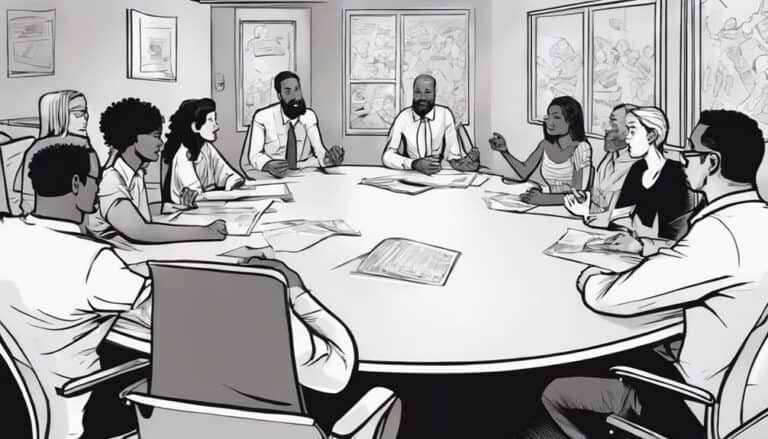To foster an environment of open and effective communication within your teams, mastering various communication modes like writing, conversing, presenting, and facilitating is important. But what truly sets exceptional leaders apart is their ability to connect authentically, listen actively, and tailor communication to individual team members.
By incorporating these best practices and honing your skills in nonverbal communication and questioning techniques, you can create a space where trust, respect, and collaboration flourish. But how do you navigate the complexities of team dynamics and guarantee your message resonates with each member?
Key Takeaways
- Foster open dialogue and active listening to build trust and understanding.
- Address communication barriers promptly to maintain a harmonious team environment.
- Promote transparency in communication to establish credibility and prevent misunderstandings.
- Encourage feedback sessions and provide communication training for effective team communication.
Importance of Communication in Leadership
Effective leadership hinges on clear and purposeful communication, a foundational element for fostering trust, understanding, and connection within a team. As a leader, your role in promoting open communication is paramount. By actively listening to your team members, you not only build relationships but also encourage them to share their thoughts and ideas freely. This creates a culture of trust where feedback is valued and acted upon promptly. Effective communication isn't just about conveying information; it's about creating an environment where every team member feels heard and understood.
To excel in leadership communication, focus on authenticity and visibility. Your team values genuine interactions over eloquent speeches. Tailoring your communication strategies to address individual concerns and using storytelling to convey visions and goals can engage your team effectively. Remember, effective communication is a two-way street. By prioritizing open and honest communication, you lay the foundation for a cohesive and high-performing team.
Overcoming Communication Barriers in Teams
To foster effective team communication, it's imperative to proactively address and overcome various communication barriers that may arise, such as language differences, cultural nuances, and generational gaps within your team.
Here are some strategies to help you overcome these barriers:
- Implement active listening techniques to assure all team members feel heard and understood, promoting a culture of open communication.
- Encourage feedback loops and regular check-ins to address misunderstandings promptly and clarify information in a timely manner.
- Utilize diverse communication channels such as emails, video calls, and team meetings to accommodate different communication preferences within your team.
- Provide communication training and workshops to enhance the communication skills of team members, fostering transparent and effective communication practices.
Strategies for Effective Team Communication
Implementing regular team meetings and check-ins is essential for fostering transparent communication and guaranteeing alignment within the team. By establishing consistent communication channels, team members can exchange ideas, provide feedback, and address concerns effectively. Utilize various platforms like emails, messaging apps, and video calls to facilitate efficient information sharing and collaboration. Encouraging open dialogue and active listening among team members helps in understanding different communication styles and building trust within the team. Acknowledge contributions and promptly address any communication barriers that may arise to maintain a productive and harmonious work environment. Here is a table to summarize key strategies for effective team communication:
| Strategies | Description | Benefits |
|---|---|---|
| Regular Meetings | Schedule periodic team meetings to discuss progress and updates. | Ensures alignment and clarity. |
| Open Communication | Encourage transparency and dialogue among team members. | Fosters trust and understanding. |
| Active Listening | Listen attentively to team members' ideas, feedback, and concerns. | Promotes a collaborative culture. |
Building Trust Through Transparent Communication
Embracing transparent communication within your team cultivates a foundation of trust and authenticity, fostering a collaborative and supportive work environment. When you prioritize transparent communication, you pave the way for stronger bonds and more effective teamwork.
Here's how you can build trust through transparent communication:
- Foster Openness: Encourage team members to share their thoughts, ideas, and concerns freely, creating a safe space for open dialogue.
- Promote Honesty: Be truthful and forthcoming in your communication, even when delivering tough messages, to establish credibility and trust.
- Resolve Conflicts Directly: Address issues transparently and promptly to prevent misunderstandings and build a culture of conflict resolution.
- Cultivate Authenticity: Lead by example, showing vulnerability and authenticity, which helps team members feel more comfortable and fosters genuine connections.
Encouraging Open Dialogue and Feedback
Encourage open dialogue and feedback to nurture a culture of transparent communication within your team. By fostering an environment where team members feel safe to express their thoughts and ideas, you promote important feedback and create a space for transparent dialogue.
Implementing regular feedback sessions or surveys can help in addressing communication barriers effectively and gathering valuable insights. As a leader, it's essential to lead by example by actively listening to your team members, acknowledging their input, and responding constructively to encourage open dialogue.
Providing training on effective communication skills equips team members with the necessary tools to express themselves clearly and openly. By fostering trust and creating a safe space for communication, you lay the foundation for a cohesive team that thrives on open and effective communication.
Leadership by example in fostering open dialogue and feedback is key to building a strong and communicative team.
Conclusion
To summarize, by embracing transparency and promoting open dialogue, leaders can break down communication barriers and build trust within their teams.
By actively listening, asking good questions, and reinforcing intent with positive body language, leaders can foster a culture of effective communication.
Remember, communication is the key to success in leadership, so prioritize authenticity and tailored strategies to guarantee alignment and collaboration within your team.

